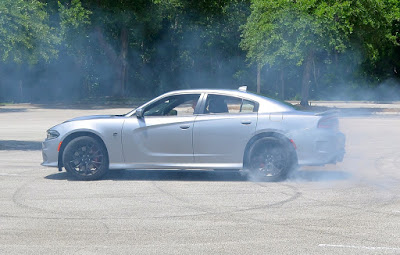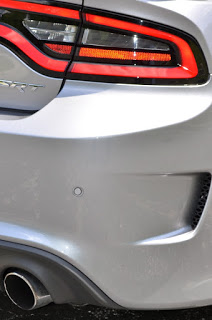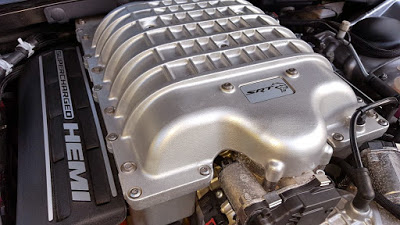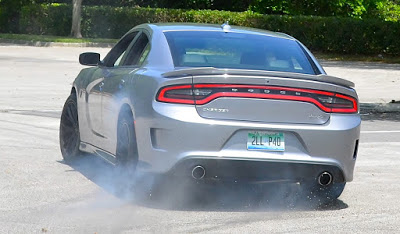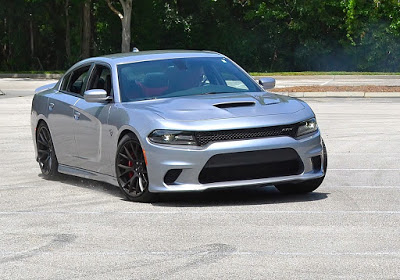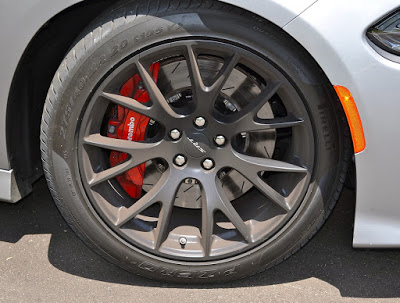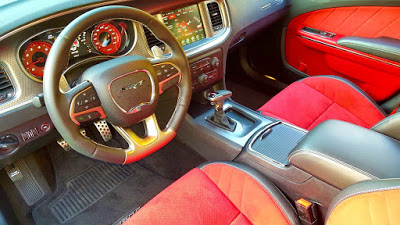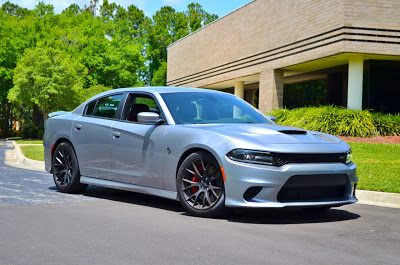Just take a drive in my neighborhood – any street will do. You’ll see a lot of Hellcat traces left behind – twin rubber stripes departing from many stop signs. Sorry Dodge – the Hellcat with 707 Hemi horsepower generating 650 pound/feet of ground-pounding torque made me do it. And, according to Dodge, it has a top end of 204 mph!
Dodge says the Hellcat’s SRT Hemi has the highest output of any passenger-car engine it’s ever produced, and they made sure we could test all 707 of its horses by handing me the red keyless remote that delivers insures max power. And I used it every day, waking up the neighbors as I fired it up, a Hellcat image welcoming me on the gauge screen before I let its rubber claw the road.
One look under the bulging hood scoop showed why the Hellcat growls – a 2,380-cc supercharged atop its 6.2 liter Hemi. The large-displacement blower’s ribbed alloy case hides integral charge coolers and an electronic bypass valve allowing a maximum of 11.6 psi boost. The cast-iron engine has die-cast aluminum rocker covers, a forged-steel crankshaft, forged-alloy pistons and a high-capacity oil/air heat exchanger. At the back end, a 2.75-inch, straight-through, twin-exhaust system. Sorry – no manual availability.
The Hellcat offers multiple driving modes. “Valet,” drops power down so you can feel safe handing it off. “Eco” drops output down to 500 horsepower and sets the transmission/suspension/traction control in its mildest mode and disables paddle shifters. “Sport” give 700-plus, dialed back traction control, paddle shifters and firmer shocks, plus full snarl from the dual exhaust. “Track” lets the Hellcat really snarl and spits on overrun, with the firmest suspension, quickest shifts and almost no traction control.
So what’ll she do? When I set our 5,000-mile-old test car to “Sport” it launched to warp speed with a feral supercharger scream, dual exhaust bellow and some wheelspin, since it lightens traction control. “Track” speeds up throttle response and loosens up traction control more. The new eight-speed automatic transmission holds gears longer, then slams lightning-fast upshifts with an exhaust bark as the car shoves me into the seat and bellows even louder. Back off and there’s a great exhaust crackle and pop.
Our last Charger R/T had a 5.7-liter HEMI V-8 with 370 horsepower and 395 pound/feet of torque, hitting 60-mph in a quick 4.7 seconds. Set the Hellcat in “Sport,” and we left twin stripes as we hit 60-mph in 4.3 seconds and 100-mph in 8. In “Track,” each of the 160-millisecond shifts slammed home as power came on with a roar and even more rubber – 100-mph in 7.9 seconds with rear tires fighting for traction and smoking.
Either way, you get wheelspin on shifts before the Pirellis grip again, including second-to-third. Use launch control –tap a button after you’ve preset your launch rpm – then gas and brake: 60 mph in 3.8 seconds and 100 in 8.8 seconds with slamming quick shifts, a wild supercharger scream and wheelspin after each shift.
Press to pass on the highway and the eight-speed immediately downshifts two gears, the supercharger whines and it GOES with a hint of rear tire wiggle. The tall paddle shifters allowed fingertip downshifts clean and quick. As for “Eco” mode, it sets the transmission to a mellower “street” mode, and disables paddle shifters. Do a highway commute and our 11-mpg rose to more than 16-mpg indicated, with a civil ride for guests. But it can still let you leave twin stripes of rear rubber pulling off an exit from a stop.
The Hellcat’s five-drive mode also change the steering and the adaptive ADS Bilstein shock absorbers, coupled to an independent short/long arm front suspension with five-link independent rear with stabilizer bars. Eco and street mode delivers sporty, firm-yet compliant. Sport is firmer, but still livable on urban and suburban roads. Track is very firm, with a hard-edged rebound over potholes, yet surprisingly forgiving.Track and Sport make this two-ton sedan handle like the rest of the Charger line should. The sedan felt lighter and tighter, with more precision in the steering feel and eager to tackle a turn.
For handling tests, I used the Custom setting and set engine, suspension and shifting in “Track,” with “Street” traction control. Play the throttle right and the Hellcat takes a set with a bit of body roll and just sails through quite neutrally. Push harder and it will understeer, easy enough to remedy with some fast-acting throttle. Tap in the Sport setting to loosen the traction control, and the rear rubber power slides. It’s big, but it behaves.
The G-Force meter claimed 1.03 lateral Gs on the skidpad. Peak acceleration was a seat-pinning 1.05 gs. The power steering gets more feel as you toggle more serious driving modes, a bit heavy at parking lot speeds, but well weighted and precise on the road. And those brakes – precise pedal feel, great initial bite and solid stopping power. We felt no fade after some very serious use at speed. With 15.4-inch Brembo two-piece rotors up front and six-piston calipers, we averaged about .68 Gs in deceleration.
As for the package this power comes in, the current shape was born from a 2011-redesign and a 2015-facelift with new hood, fenders and slimmer front and rear fascias, including the loss of the crosshair grille. The lightweight aluminum hood has a low, wide center hood scoop flanked by sunken vents.
Subtle fender flares wrap tightly around P275/40ZR20-inch Pirelli P-Zero rubber on Hyper Black Slingshot split-seven spoke forged-aluminum wheels that show off huge Brembo disc brakes with red calipers. A snarling Hellcat badge decorates the front fenders forward of the side scallops. There’s a substantial wing atop the trunk lid at the base of the fastback rear window. It all rides a cat’s whisker lower than regular Chargers.
Inside, there’s a padded black dashtop and sculpted red suede heated and ventilated bucket seats with black leather outers, contrasting stitching. They could use a bit more side bolstering especially when the Hellcat starts roaring. The red-faced gauges live in an engine-turned metal-like surround, a 200-mph speedometer and 7,000-rpm (6,000-rpm redline) tach framing a 7-inch color screen that displays a digital speedometer, fuel economy, engine power and torque and tire pressure gauges. There is turbo boost, turbocharger/intercooler/coolant/oil/transmission displays, plus voltage and g-forces. Plus 0 to 60 mph and 0 to 100 mph timer, plus quarter and eighth-mile, lap speeds and top speed.
Center stage is the 8.4-inch Uconnect screen that handles navigation, smartphone, backup camera, Sirius TravelLink weather/traffic/stocks/gas prices and a lot of Uconnect apps. That screen also contains a Performance Control display. It shows speed and braking, engine gauges and acceleration, braking G force and steering angle. You can set up launch control that allows a preset engine rpm for dragstrip launches. The SRT page allows you to set up comfort/normal/sport steering, pedal, engine and transmission response and programmable drive modes.
A base V-6 Charger SE starts at $27,995, while our 707-horsepower Hellcat started at $65,945 and with a $1,995 harmon-kardon stereo, $595 Pirelli P Zero summer tires and – no surprise – a $1,700 Gas Guzzler tax. Final price – $71,230.
For more information on the latest and hottest Chargers from Dodge, please visit http://www.dodge.com/en/charger/
Link to Dan Scanlan’s Hellcat video
https://www.youtube.com/watch?v=NWFYO7sPtsY

